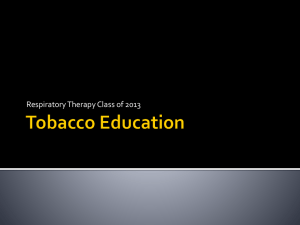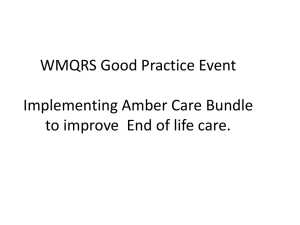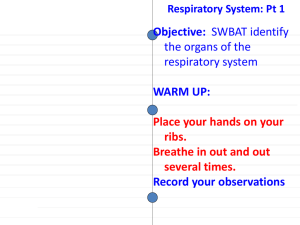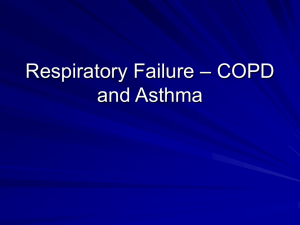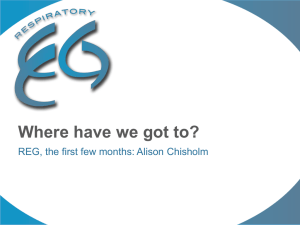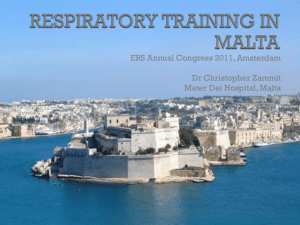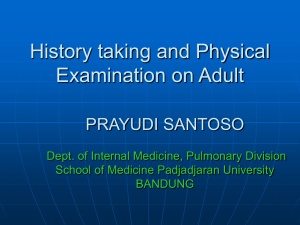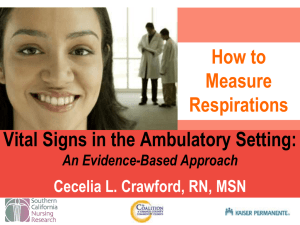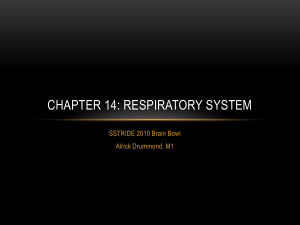Respiratory
advertisement
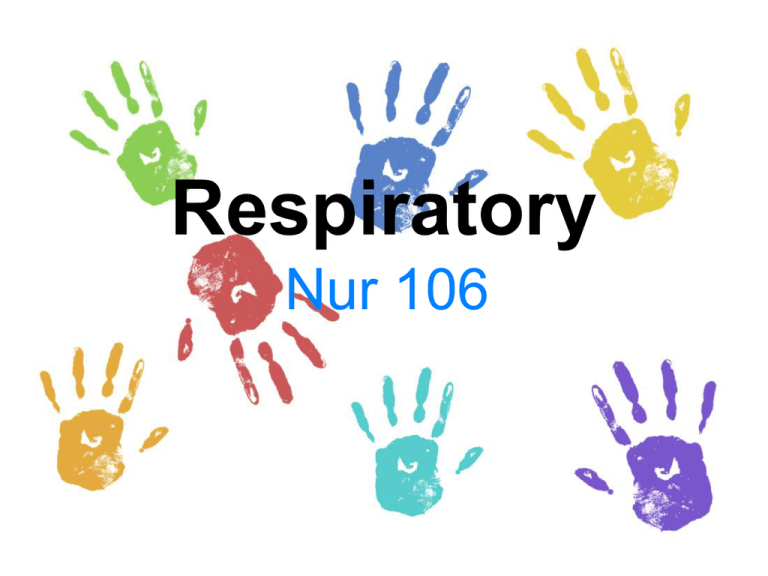
Respiratory Nur 106 Respiratory System • General Information • Signs and symptoms of respiratory distress • Common diagnostic tools • Common medications and treatments General Information • • • • • Fetus practices breathing in utero Normal to have amniotic fluid in lungs Absorbed as soon as takes first breath Meconium in the amniotic fluid is problem Surfactant reduces surface tension in lungs so that lungs will remain open • Neonates are obligant nasal breathers General Information • Normal respiratory rate: 30—50 • Lumen of respiratory system is smaller in children • Eustachian tubes shorter and more horizontal • Metabolic rates are higher than adults Respiratory Assessment • Auscultation – Absent or diminished lung sounds – Adventitious lung sounds • Crackles—passage of air through moisture • Wheezes—Narrowed passageways Respiratory Assessment • Observation – Barrel Shaped Chest Respiratory Assessment • Observation – Cyanosis – Club fingers Respiratory Assessment • Observation – Presence of retractions • Occur when airway obstructed in young children • Indication of severity of respiratory distress Respiratory Assessment • Infant’s chest walls more flexible, muscles immature, retractions common Respiratory Assessment • Retractions Suprasternal Intercostal Substernal Common Diagnostic Tests • Chest xray • Bronchoscopy—visualizes trachea and bronchi directly – Under anesthesia • Pulmonary function tests—usually not until 5 to 6 years of age • Sputum culture—best collected in morning Common Diagnostic Tests • Arterial blood gases – Heparinized syringe – Place on ice – Transport to lab immediately – Pressure to site for 5 minutes • Pulse oximetry – Oxygen saturation – SPo2 – 87—93% safe levels of saturation Respiratory System • • • • • • Laryngotracheobronchitis (croup) Pnuemonia Respiratory distress syndrome Bronchopulmonary dysphasia Cystic Fibrosis Sudden Infant Death Syndrome (SIDS) Respiratory System • • • • • • Asthma Respiratory Syncyntial Virus Pharyngitis Allergic Rhinitis Tonsillitis/adenoiditis Influenza Laryngotracheobronchitis • Generalized infection of larynx, trachea and bronchi • Croup • Frequently shows symptoms of mild URI during day; at night, awakens with hoarse barking cough and severe respiratory distress • Most common organisms: RSV, parainfluenza virus and mycoplasma pneumoniae LTB Etiology • Affects children under 5 (smaller airways) • Affects boys more frequently than girls • Inflammation causes narrowing of airways • Onset gradual • May reoccur several nights in a row LTB Symptoms • • • • • Low-grade fever Barking cough Respiratory stridor Hypoxemia Tripod position Respiratory Distress Tripod Position LTB Treatment • At home: – Hot steamy bathroom – Cool night air – Sit upright – Cool mist vaporizer in “home made tent” – Elevate head of crib – Increase fluids LTB Treatment • Hospitalization – Croup tent – IV fluids—oral fluids may cause aspiration – Bronchodilators – Corticosteroids – Intubation equipment available Epiglottitis • • • • Inflammation of epiglottis Life threatening obstruction Usually bacterial (hemophilus influenza) Sudden onset in healthy child: awakens with high fever, drooling and respiratory distress • Do NOT examine throat—may lead to spasm and complete obstruction Pneumonia • Inflammation/infection of bronchioles and alveloar spaces • Causative agents bacteria, viral, mycoplasma – Children under 5: Viral—RSV. Influenza, adenovirus,rhinovirus – Children over 5: Bacteria—streptococcus pneumoniae Pneumonia • Symptoms – Fever, cough, dyspnea, tachypnea – Rhonchi, crackles, wheezes – Decreased breath sounds with consolidation • Diagnosis – Xray • Treatment – Antibiotics, IV, fever control, airway management Respiratory Distress Syndrome • Formally called Hyaline Membrane Disease • Disease primarily of premature – Infant of a diabetic mother – White children more frequent than black – Boys more often than girls • Primary pathology is production deficiency in surfactant Surfactant Lung Compliance Atelectasis PO2 Anaerobic metabolism Adapted from: London, M; Ladewig, P; Ball, J; and Bindler, R. 2007. Maternal & Child Nursing Care, 2nd ed. Upper Saddle River, NJ, Prentice Hall, p.820. M e t a b o l i c Work of breathing Acidosis R e s p i r a t o r y Ventilation CO2 Respiratory Distress Syndrome • Diagnosis: x-ray—diffuse bilateral density (white-out), and atelectasis • Antenatal prevention treatment: betamethasone Respiratory Distress Syndrome Nursing Care • Oxygenation/ventilation – Transcutaneous oxygen/CO2 monitoring – Blood gas monitoring – Oxygen – Continuous positive airway pressure (CPAP) – Respirator Respiratory Distress Syndrome Nursing Care • Correction of acid-base imbalance • Temperature regulation • Nutrition • Protect from infection Respiratory Distress Syndrome • Surfactant Replacement Therapy – At birth and repeated as necessary – Endotracheal administration Bronchopulmonary dysplasia • BPD • Chronic lung disease • Precipitating factors: prematurity, high oxygen concentrations, positive pressure ventilation • Symptoms: Persistent respiratory distress – Wheezing, tachypnea, pulmonary edema – Failure to thrive Bronchopulmonary Dysplasia • Nursing Care – Oxygen – Tracheostomy – Recurrent respiratory infections • Palivizumab, RSV immune globulin – Promote growth and development Bronchopulmonary Dysplasia • Medications: – Bronchodilators – Anti-inflammatory agents – Diuretics – Antibiotic Therapy – Vitamin A Cystic Fibrosis • Inherited—autosomal recessive – Both parents must be carriers – Each child has a 1 in 4 chance of being affected – Affects primarily white children Father (carrier) Carrier Unaffected Mother (carrier) Affected Carrier Cystic Fibrosis • Multi-system disease—affects exocrine glands – Bronchioles, small intestines, pancreas, bile ducts • Exocrine secretions—thick and tenacious • Abnormal sodium excretion – Sweat Chloride test – Heat Prostration Cystic Fibrosis • Lungs—Secretions pool in bronchioles leading to infection and atelectasis – Barrel shape chest – Cyanosis – Clubbing of fingers and toes – Recurrent respiratory infections Cystic Fibrosis • Pancreas—absence of pancreatic enzymes and malabsorption • Small intestine—Meconium hardens leading to meconium ileus – Stools are bulky and fatty (steatorrhea) – Large belly, wasted extremities – Fat soluble vitamin deficiencies Cystic Fibrosis • Males usually sterile due to blocked vas deferens • Females may have trouble conceiving due to thick mucus in the reproductive tract Cystic Fibrosis • Medical treatment – Bronchodilators – Antibiotics – Pancreatic enzymes – Vitamin supplements – Salt supplements in hot weather? Cystic Fibrosis Nursing Interventions • At birth—monitor for 1st meconium – Newborn screening—blood immunoreactive trypsinogen • Genetic counseling • Parent Education – – – – High calorie, high protein, low fat diet How to administer pancreatic enzymes Protect from infection Breathing exercises and care Cystic Fibrosis Breathing Exercises • Physical activity • Chest percussion and postural drainage Cystic Fibrosis Medications • • • • • • Aerosol Bronchodilators—opens lungs Aerosol DNAse—loosens secretions Corticosteroids—Anti-inflammatory Antibiotics—Treats infections Pancreatic enzymes—Aids in digestion Water soluble ADEK Sudden Infant Death Syndrome • Risk factors--infant – Race: (decreasing order of frequency) American Indian, black, Hispanic, white, Asian – Males more often than females – 2—4 months of age – Winter – Exposure to passive smoke – Prone sleeping – Overheating Sudden Infant Death Syndrome • Risk factors--maternal – Age less than 20, short interval between pregnancies – Prenatal smoking, binge alcohol, drug use – Anemia – Poor prenatal care, poor weight gain during pregnancy – Hx of sexually transmitted disease or UTI Asthma • Hyper-reactive lungs • Chronic condition with acute exacerbations • Responds to environmental irritants • Bronchial spasm, increased airway resistance, air trapping Asthma--Etiology • Triggers include: inhalants, airborne pollens, stress, weather changes, exercise, viral or bacterial agents, allergens, strong emotions, etc. • Runs in families—genetics unclear Asthma--Pathology • Exposure to irritant • Constriction of bronchial smooth muscles • Edema of lung tissues • Increased respiratory secretions • Airway narrowing – Air trapping and hyperinflation of alveoli Asthma--Symptoms • Wheezing—can be heard at http://jan.ucc.nau.edu/~daa/heartlung/breaths ounds/contents.html • Cough • Air trapping and hyperinflation leads to prolonged expiratory phase • Lips—dark red; may progress to cyanosis • Anxiety • Sitting upright, hunched over Asthma Treatment • Quick relief medications – Nebulizer (metered dose inhaler)—note if contains steroids, spacer should be used to prevent yeast infections of the mouth Asthma Metered Dose Inhaler--Use • • • • Shake the inhaler well before use (3 or 4 shakes) Remove the cap Breathe out, away from your inhaler Bring the inhaler to your mouth. Place it in your mouth between your teeth and close you mouth around it. • Start to breathe in slowly. Press the top of you inhaler once and keep breathing in slowly until you have taken a full breath. • Remove the inhaler from your mouth, and hold your breath for about 10 seconds, then breathe out. www.asthma.ca/adults/treatment/meteredDoseInhaler.php Asthma Medications--Acute • Corticosteroids—oral or inhaled – Prednisone, Methylprednisolone • Β-Adrenergic agonists (Bronchodilators) – Albuterol, epinephrine, terbutaline – Short acting (inhaled) used to relieve an on-going attack – Long acting (oral or inhaled) to control frequent attacks Asthma Medications--Chronic • Cromolyn sodium—used prophylactically – Inhalant – Suppresses inflammation – Not bronchodilator – Prevents release of histamine Asthma Reducing Triggers • Smoke free environment • Allergy proofing home: – Bedroom of primary importance – Pillows and mattress enclased in covers – Eliminate stuffed toys, plants, carpets, drapes – Do not store out of season clothing in room Status Asthmaticus • The continued presence of severe respiratory distress despite vigorous therapeutic measures • Medical emergency that can lead to respiratory failure and death • Sudden onset of agitation or the agitated child who suddenly becomes quiet may be seriously hypoxic Bronchiolitis • Inflammation of the bronchioles • Edema, accumulation of mucus, air trapping and atelectasis • Major concern for small infants • Most common caustive agent is the respiratory syncytial virus (RSV) • Often fatal RSV • Most important respiratory pathogen in infancy and early childhood • Not airborne • Can remain viable for hours on nonporous surfaces • Most frequent problem in winter and spring RSV Prevention • Infants up to 24 months with chronic lung disease – RSV Immune Globulin (RSV-ICIV): Antibodies against RSV. Given monthly IV beginning of season – Palivizumab (monoclonal antibody): Given monthly IM Pharyngitis • “Sore throat” • Most are caused by viruses • Most common bacteria—group A betahemolytic streptococcus (strept throat) • Symptoms—fever, sore throat, dehydration • Treatment—symptomatically • If bacterial—10 days of penicillin Tonsillitis/adenoiditis • Tonsils: Masses of lymphoid tissue located in pharyngeal cavitiy. • Purpose: Filter pathogens • Size: Children relatively large • Infection can be viral or bacterial • If greater than 3 infections per year, may do tonsillectomy Tonsillectomy • Surgical removal of palatine tonsils • Adenoidectomy—surgical removal of pharyngeal tonsils • Pre-op prep same as for all surgeries Tonsillectomy • Recovery room – Position on abdomen or side – Suction with care • Tonsillectomy • Post op care – Bedrest for day – Clear liquids advance to full then soft • Cold • Avoid red coloring – Ice collar – Analgesics Tonsillectomy • Post op risk—hemorrhage • Up to 10 days post op • Symptoms – Bright red bloody emesis – Frequent swallowing – Pulse greater than 120 Tonsillectomy • Recommendations to prevent post-op hemorrhage – – – – – – Avoid irritating foods Avoid gargles or vigorous toothbrushing Discourage coughing or throat clearing Use ice collar Avoid medications known to promote bleeding Limit activity Allergic Rhinitis • Hay fever • Seen mostly in older children and adults • Treatment: antihistamine, allergy avoidance Influenza • Viral • Symptoms last 4 to 5 days • Complications include pneumonia, encephalitis, otitis media • Do not treat with aspirin because of possible link to Reye Syndrome General Treatment for Respiratory Conditions • • • • • Position to promote oxygenation Humidification Fluid intake—clear liquid, avoid milk Oxygen??? Medications include bronchodilators, anti-inflammatories, antibacterial and antiviral agents Foreign Body Aspiration • • • • • • • Peak age: under 3 Leading cause of death under 1 FB usually lodge in right main bronchus Partial or complete obstruction Sudden onset of coughing Heimlich Maneuver Surgical removal
